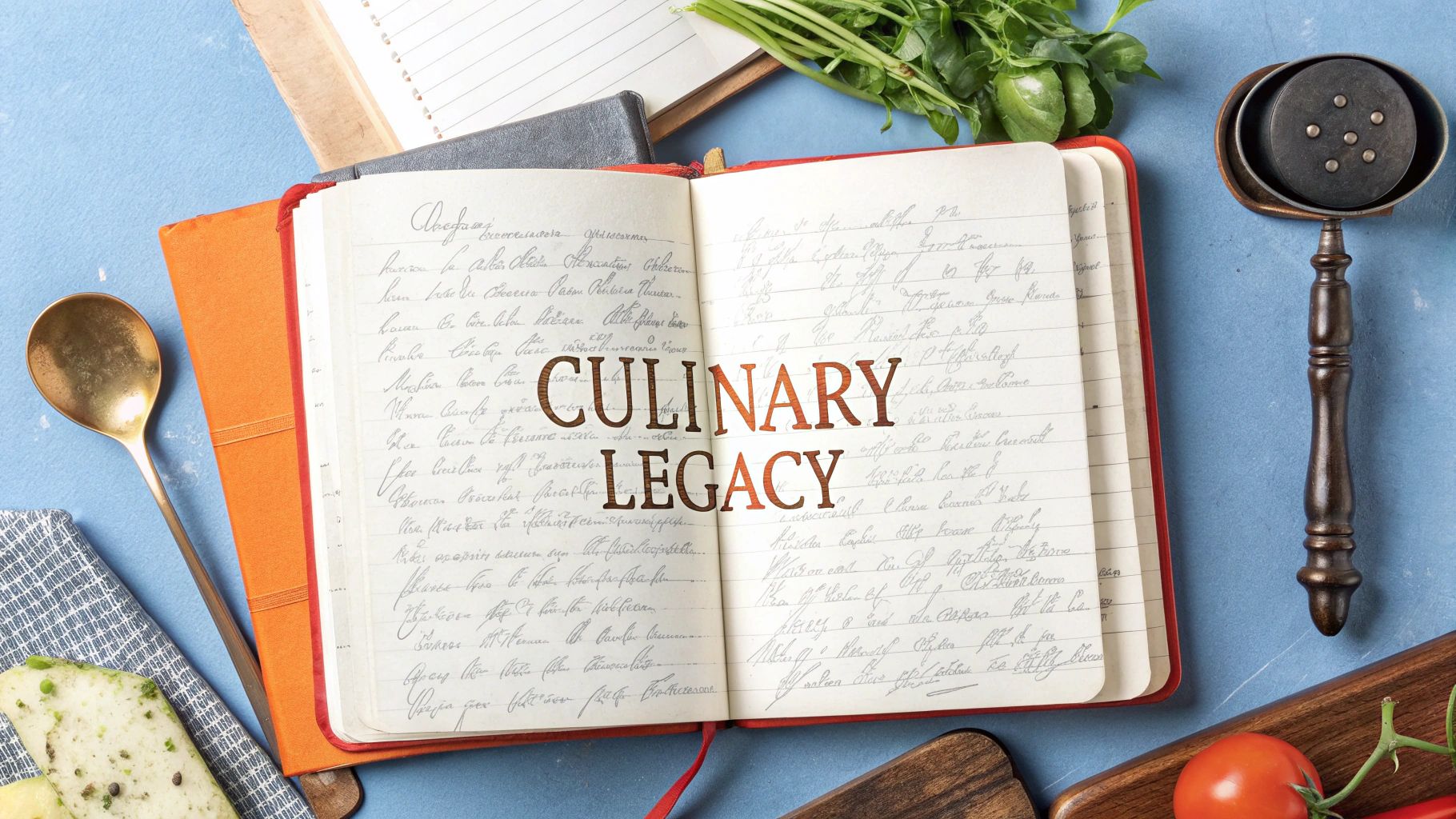Why a Personalized Recipe Journal Becomes a Family Treasure
A personalized recipe journal is more than just a place to keep your favorite dishes. It's a tangible record of your family's culinary history, a way to connect with loved ones through shared meals and traditions. Unlike digital recipe platforms, a handwritten journal offers a unique tactile experience. It creates a deeper connection with the recipes themselves, fostering a sense of intimacy a screen can't replicate. Think of it like holding a treasured family photo versus seeing it online; the physical object holds weight, memory, and emotion.
Preserving Family Narratives Through Food
Recipes often carry stories and memories passed down through generations. A personalized recipe journal lets you capture these narratives, adding personal anecdotes alongside the ingredients. This transforms a simple list of ingredients into a cherished story, rich with family history. For example, you could include a note about your grandmother's secret ingredient for her apple pie or the story behind a dish served at every holiday gathering. You might be interested in: How to master the perfect personal recipe book.
A Tangible Legacy of Flavors
Handwriting a recipe, unlike copying and pasting it digitally, strengthens the connection to the dish. The physical act of writing engages different parts of the brain, improving memory and creating a more lasting impression. Your journal becomes a living document, evolving with your family's culinary journey. The personalized touches, like handwritten notes and sketches, add a unique and irreplaceable value.
The Unexpected Benefits of Journaling
Many dedicated journal keepers find unexpected benefits beyond preserving recipes. They find that journaling sparks culinary creativity. Documenting their cooking encourages experimentation and the development of new dishes. It also fosters a deeper appreciation for their personal food journey, highlighting how their tastes and preferences evolve. Historically, personalized recipe journals have benefited from a surge in home cooking. This is reflected in the projected growth of the paper cookbook market from $7,742.93 million in 2024 to $11,770.76 million by 2032, growing at a CAGR of 6.2% from 2026 to 2032. Find more detailed statistics here: https://www.verifiedmarketresearch.com/product/paper-cook-books-market/.
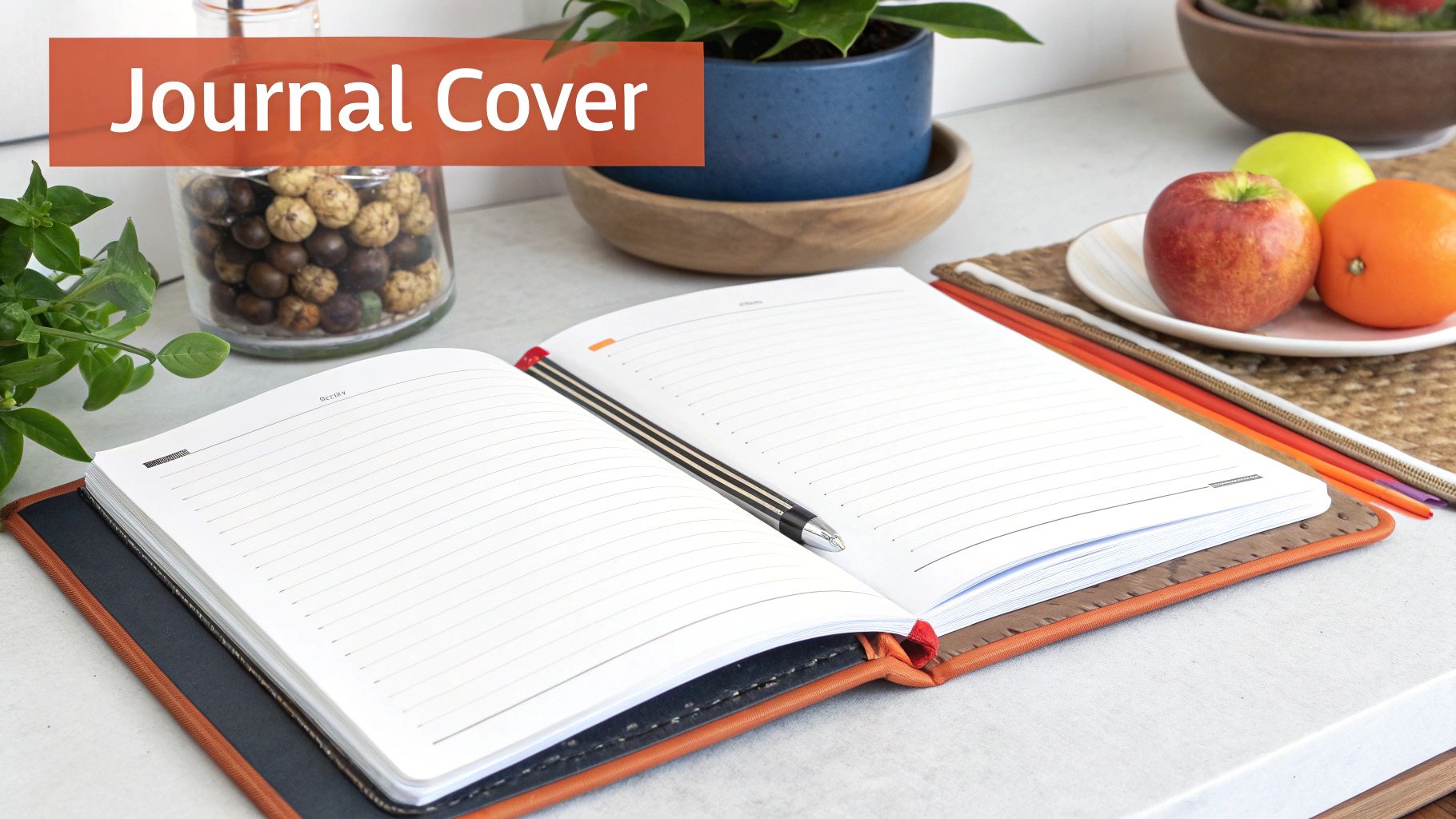
A personalized recipe journal becomes a treasured item, filled with not just recipes, but the memories and stories that connect generations. This tactile collection offers a unique way to preserve family history and create a lasting legacy of flavors.
Selecting the Perfect Journal Format for Your Cooking Style
Finding the right format for your personalized recipe journal is crucial for long-term usability and enjoyment. This isn't just a notebook; it's a record of your culinary journey. The format you choose should support how you cook and how you want to use your journal.
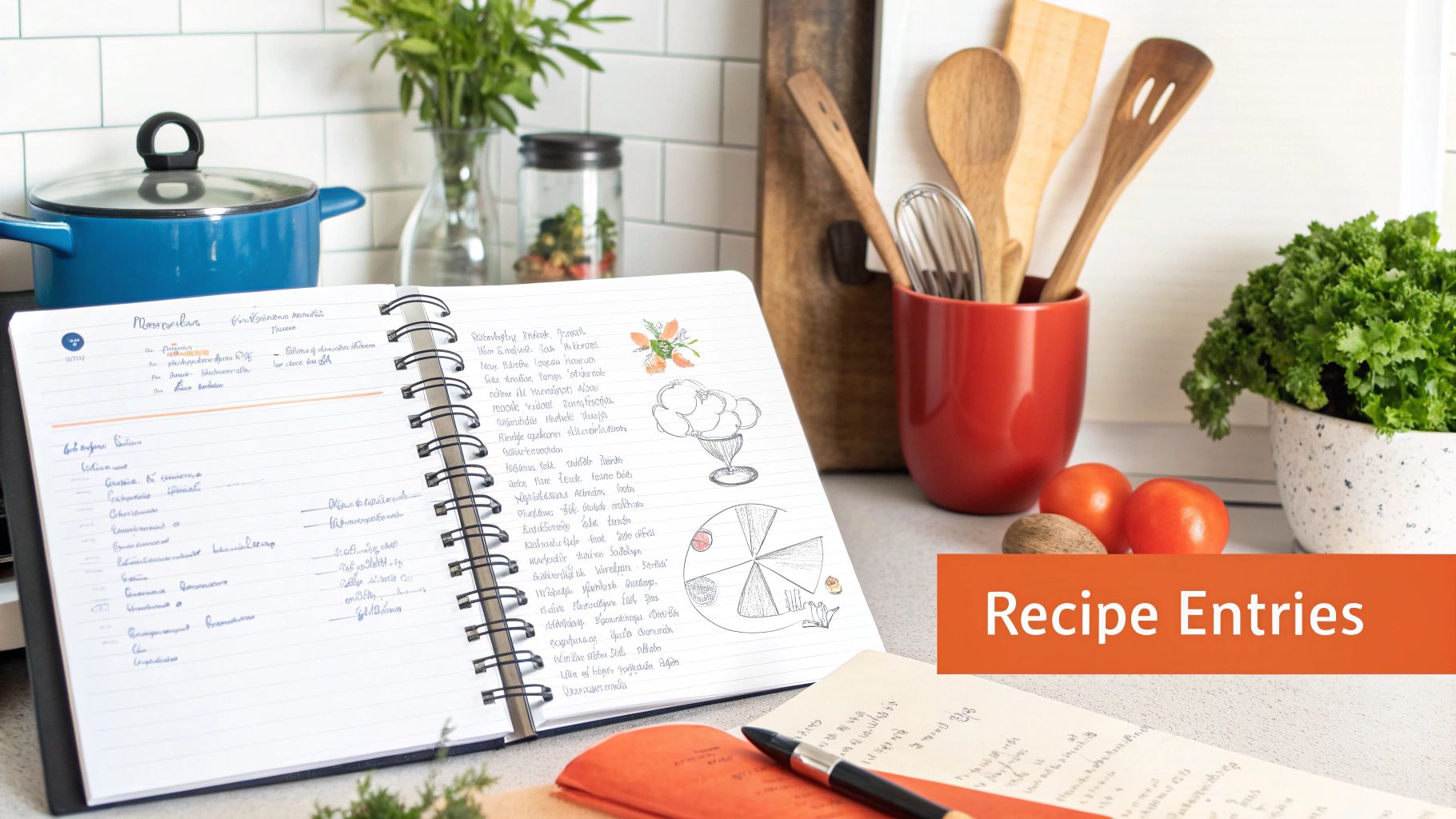
Journal Types: A Quick Overview
Several formats offer distinct advantages for different cooking styles. The "perfect" personalized recipe journal is the one that best suits your individual needs.
-
Ring-Bound Journals: These are excellent for adding and removing pages, allowing for recipe adjustments and expansions. They also lie flat, which is convenient for in-kitchen use.
-
Spiral-Bound Journals: Similar to ring-bound journals, spiral-bound options are a cost-effective choice for simpler recipe collections. They are less adaptable when it comes to adding or removing pages.
-
Hardbound Journals: These offer a classic, heirloom quality. While aesthetically pleasing, they might be less practical for active kitchen use due to their inflexibility.
-
Loose-Leaf Binders: These provide maximum flexibility. You can customize the organization with ease, adding printed recipes or handwritten notes as you please.
To help you compare these options, here's a handy table summarizing the key differences:
Personalized Recipe Journal Format Comparison: A detailed comparison of different journal formats, highlighting their features, benefits, and best uses.
| Journal Type | Key Features | Best For | Durability | Price Range |
|---|---|---|---|---|
| Ring-Bound | Add/remove pages, lies flat | Active cooks, expanding collections | Moderate | Mid-range |
| Spiral-Bound | Cost-effective, simple | Smaller collections, budget-conscious cooks | Moderate | Low-range |
| Hardbound | Classic look, heirloom quality | Display, gifting | High | High-range |
| Loose-Leaf Binder | Maximum flexibility, customizable organization | Printed recipes, varied content | High | Mid-range |
As you can see, each journal type has its own strengths. Consider your cooking habits and how you plan to use your journal when making your decision.
Paper Quality and Size Considerations
Beyond the binding, paper quality is an important factor. Consider your cooking environment. A journal used frequently in the kitchen benefits from thicker, spill-resistant paper. This will keep your recipes legible, even with occasional splatters. Size is another consideration. A larger format provides ample space for detailed notes and illustrations. A smaller size, however, might be more practical for quick reference while cooking.
Organization and Your Cooking Approach
How you organize your journal dramatically affects how useful it will be. If you cook seasonally, consider dividing your journal by season. For example, you might have sections for spring, summer, fall, and winter recipes. If you prefer to organize by meal type, consider creating sections for appetizers, entrees, and desserts. Creating a personalized index or table of contents can enhance accessibility. This makes it easier to find specific recipes quickly. You could also use a system of cross-referencing, linking related recipes or variations. For example, link your basic tomato sauce recipe to dishes using it, such as pasta sauces or pizza toppings.
Organizing Your Personalized Recipe Journal for Daily Use
Transforming your personalized recipe journal from a treasured keepsake into a practical everyday tool in the kitchen requires thoughtful organization. Much like planning the structure of wireframes is essential for UX design, a well-organized recipe journal ensures easy access to your favorite dishes. This prevents your journal from becoming another unused item gathering dust on the shelf.
Practical Organization Methods
Several methods can help you create a truly functional recipe journal. These range from simple categorization to more complex systems.
-
Category-Based Divisions: A classic method is dividing your journal into sections like "Appetizers," "Main Courses," and "Desserts." This provides a clear and simple way to browse your recipes.
-
Seasonal Groupings: Organize recipes by season, using the natural availability of ingredients as your guide. This is perfect for cooks who enjoy using fresh, seasonal produce.
-
Cuisine-Specific Sections: Create dedicated sections for different cuisines, such as Italian, Mexican, or Thai. This helps you easily plan themed meals or explore specific culinary traditions.
Also, consider your cooking style and how you search for recipes. Do you search by ingredient, cooking method, or occasion? Tailor your organization system to suit your individual needs.
Enhancing Functionality With Indexing and Tabs
Simple additions like indexing and tabs can greatly enhance your journal's usability, similar to tips found on how to organize recipes. These features add a professional touch and make finding recipes a breeze.
-
Creating an Index: An alphabetical index of all your recipes functions like a table of contents in a cookbook, providing a quick reference guide.
-
Using Tabs or Dividers: Tabs or dividers separate sections within your journal, offering instant access to specific categories or cuisines.
-
Cross-Referencing: Connect related recipes. For example, link a sauce recipe to dishes that use it.
These simple tools transform your journal into a personalized and efficient culinary resource.
Maintaining Flexibility and Growth
Your recipe journal should adapt as your cooking skills and recipe collection expand. A flexible organizational system is key.
Consider leaving blank pages at the end of each section for new recipes. This prevents overcrowding and helps maintain a sense of order as your collection grows.
Be open to refining your organizational system over time. What works initially may not be ideal as your journal fills up. You might begin with basic categories and later add seasonal or cuisine-based sections. This adaptability is a key advantage of a physical journal.
Interestingly, the growing popularity of personalized recipe journals parallels trends in the digital world. The global recipe app market, valued at $1.25 billion in 2024, is projected to reach $1.41 billion in 2025, a CAGR of 13.5%. This growth reflects increasing interest in home cooking and personalized culinary tools. While digital platforms offer AI-powered suggestions, physical journals provide a tangible, hands-on experience. Learn more about the recipe app market here. This blend of digital and physical options caters to a wide range of cooking styles.
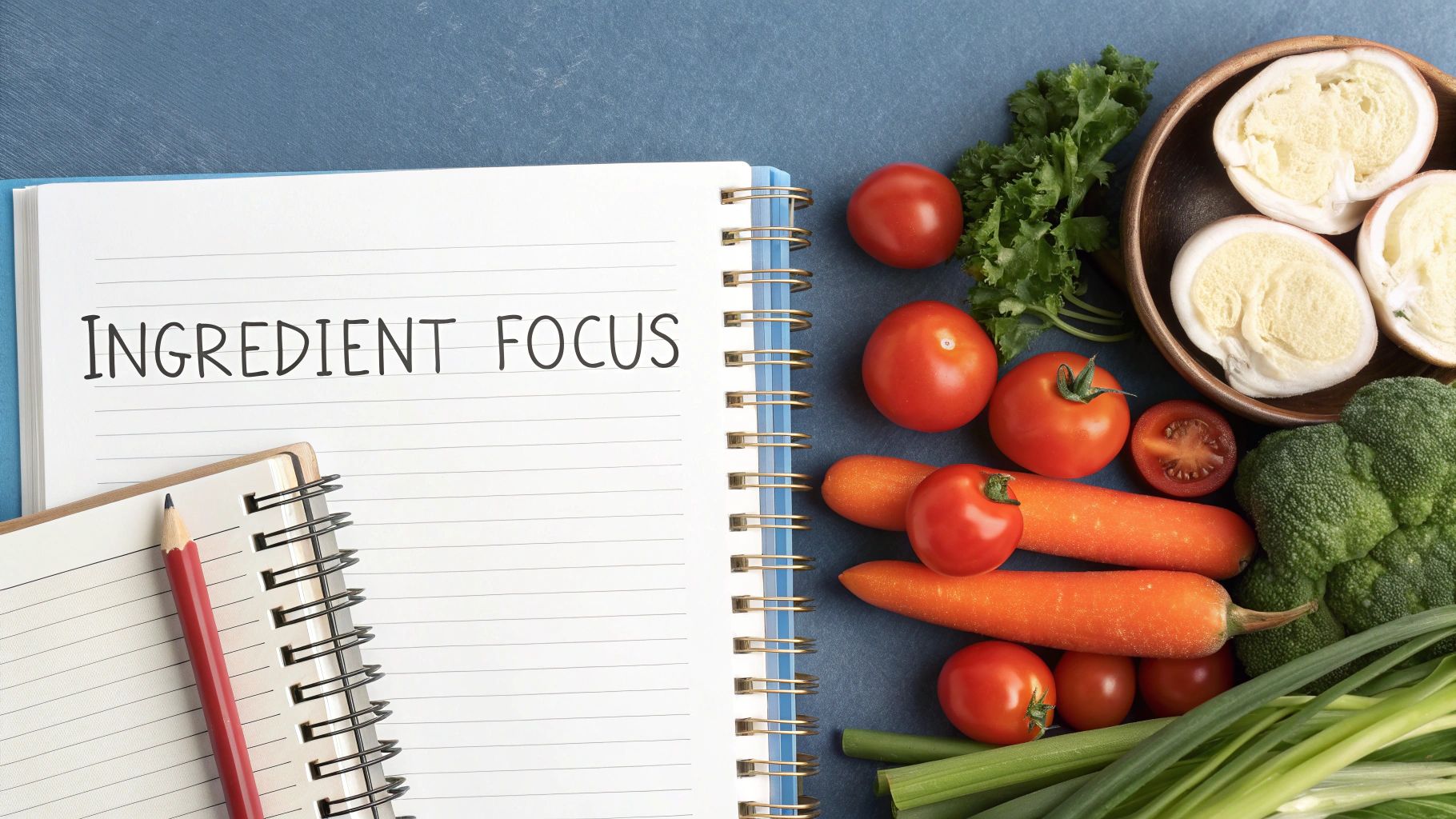
Documenting the Stories Behind Your Culinary Creations
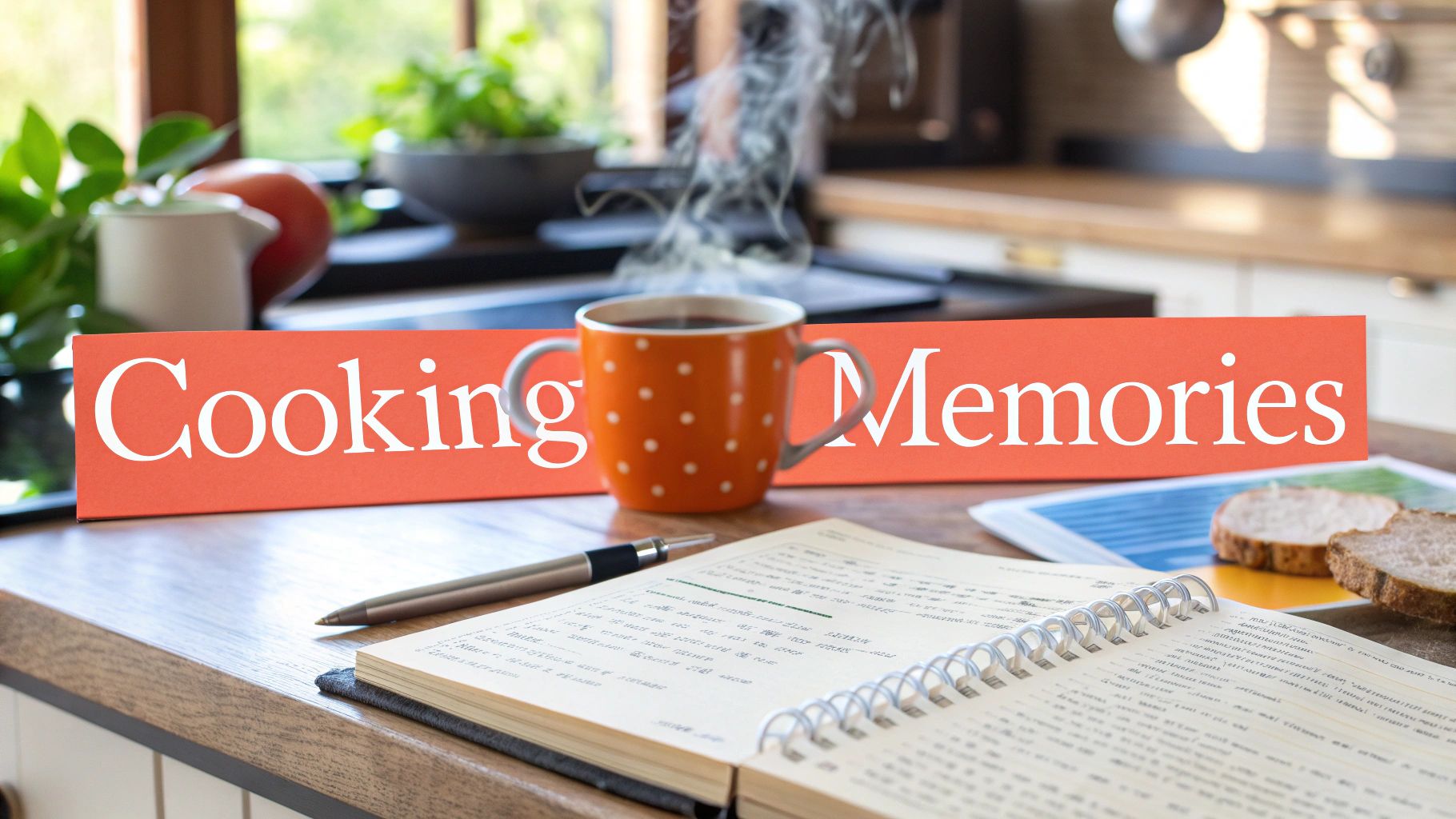
A personalized recipe journal is more than just a place for ingredients and instructions. It's a way to capture the stories and memories that make each dish special. This transforms a simple notebook into a cherished heirloom, a living testament to your family's culinary history.
Recording Family History Through Food
Food is often at the heart of family traditions. A personalized recipe journal helps you document these connections. You can record where a recipe originated, noting who created it and when. Include details about special occasions featuring the dish. This turns your journal into a rich tapestry of family history, connecting you to the past and preserving it for future generations.
Capturing The Evolution of Recipes
Recipes change over time. Your journal is the perfect place to track those changes. Note any adjustments, whether due to personal preference or ingredient availability. If you substitute due to an allergy, record it. This detailed record allows you to recreate not just the dish but the specific circumstances surrounding its creation.
Preserving Sensory Details and Memories
The best recipe journals go beyond the basic recipe. They capture the sensory details that truly bring a dish to life. Describe the aroma of the spices, the textures of the ingredients, and even the sounds of the kitchen. These small details evoke powerful memories, transporting you back to specific meals and moments. Often, brief notes scribbled in the margins become the most cherished parts of a family recipe collection. A tidy cooking space enhances the experience. Check out these kitchen organization ideas for maintaining a clutter-free environment.
The Power of Narrative
The stories and memories in your journal make it truly unique. They add depth and meaning to your recipes, transforming a simple set of instructions into a cherished family heirloom. Documenting these stories elevates your journal from a functional tool to a treasured possession, filled with the heart and soul of your family's culinary journey.
Creative Elements That Make Your Recipe Journal Uniquely Yours
A personalized recipe journal is more than just a handy place to keep your favorite dishes. It’s a reflection of your personal culinary journey, a story told through flavors and memories. Transforming your journal from a simple list of ingredients into a cherished keepsake involves adding those special creative touches that make it truly yours. You don't need to be a professional artist to achieve this. Even simple additions can have a big impact. Think of your journal as a blank canvas waiting for your creative expression.
Simple Artistic Touches for Every Journal
Even the smallest artistic elements can greatly enhance your personalized recipe journal. These additions don’t have to be complicated or take hours to create.
-
Watercolor Food Illustrations: A simple watercolor sketch of a key ingredient adds visual flair to any recipe page. A quick splash of color can bring the page to life.
-
Basic Hand-Lettering: Try experimenting with different lettering styles for recipe titles or section headings. This personalizes your journal and makes it visually appealing.
-
Meaningful Photographs: Include photos of your finished dishes, family gatherings enjoying the meal, or even the raw ingredients themselves. This creates a visual diary of your culinary adventures. You could even include pictures from the farmer's market where you sourced a special ingredient.
-
Cooking Mementos: Incorporate small mementos like dried herbs, spice labels, or ticket stubs from food-related events. These add a tactile dimension to your journal.
These elements create a multi-sensory experience, engaging not just your sense of taste but also your senses of sight and touch.
Practical Methods for Visual Interest
Creating visual appeal doesn't have to be difficult. There are many easy-to-use tools and techniques that can elevate your journal's aesthetic.
-
Washi Tape: Use decorative washi tape to create borders, dividers, or highlight your favorite recipes. It’s an easy way to add pops of color and personality.
-
Food-Themed Stamps: Stamps featuring fruits, vegetables, or kitchen utensils can add a touch of whimsy to your recipe pages.
-
Quick Sketches: Even the simplest sketches, like a quick drawing of a herb or spice, can add visual charm to your journal.
These simple additions create visual interest without demanding a lot of time or artistic talent. The goal is to create a journal that is both beautiful and practical, just like a well-designed and organized kitchen.
Inspiration From Journal Artists and Maintaining Consistency
Many journal artists showcase the balance between beauty and practicality, offering great inspiration for visually appealing and user-friendly journals. Look to established food bloggers and recipe creators for ideas. For instance, Martha Stewart often shares glimpses into her own meticulous record-keeping, demonstrating how she documents her culinary creations. You can find insights into her approach through platforms like her blog, The Martha Blog.
When incorporating these creative elements, aim for consistency throughout your journal. This helps create a cohesive look and feel. However, avoid overdoing the decoration. It shouldn’t interfere with the journal's main purpose: documenting your recipes. Your personalized recipe journal should be a beautiful and functional tool that you enjoy using in the kitchen.
Expanding Your Personalized Recipe Journal Beyond Recipes
A personalized recipe journal is more than just a place for ingredients and instructions. It's a chronicle of your culinary journey, a living document of your evolving relationship with food. It becomes truly unique when you add elements that reflect your personal tastes and experiences.
Enhancing Your Journal with Culinary Explorations
Think of your recipe journal as a culinary scrapbook. Just like a scrapbook holds photos and mementos, your journal can hold a treasure trove of information related to your cooking adventures. Creating dedicated sections for specific culinary explorations enhances its value as a personalized reference.
-
Seasonal Meal Planning: Dedicate sections for each season and jot down meal ideas that use seasonal produce. This helps you make the most of fresh ingredients and sparks your creativity.
-
Farmers Market Finds: Document your discoveries from local farmers markets. List specific vendors, unique ingredients, and inspiration for new dishes. This helps you connect with your local food community and preserves memories of special finds.
-
Flavor Combinations: Keep track of flavor pairings you love, whether you create them or discover them elsewhere. This personalized touch transforms your journal into a valuable resource for future recipe development. Imagine having your favorite flavor profiles at your fingertips!
-
Wine Pairings: Note wines that complement your recipes. This adds a touch of sophistication to your journal and helps you create well-rounded dining experiences, especially helpful for entertaining or special occasions.
These additions transform your journal into a dynamic culinary resource tailored to your preferences and experiences.
Documenting Kitchen Experiments and Discoveries
Your journal can also serve as a laboratory notebook for your culinary experiments. It’s a place to record not only your successes, but also the lessons learned along the way.
-
Kitchen Experiments: Document the results of your culinary trials, noting both successes and failures. This will help you refine techniques and develop your skills as a cook. It's like having a personal cooking class record.
-
Technique Improvements: As you hone your cooking skills, write down any improvements or adjustments you make to existing recipes. This provides a record of your growth and prevents repeating past mistakes.
-
Equipment Notes: Keep an inventory of your kitchen equipment, including preferred brands, maintenance tips, and even a wish list for future acquisitions. This information is incredibly useful when replacing or upgrading items.
-
Travel-Inspired Dishes: Document food discoveries from your travels. Record recipes you try, unique ingredients you encounter, and restaurant recommendations. This creates a flavorful travel log within your culinary journal.
This detailed documentation reflects your ongoing relationship with food. Learn more about digital recipe management in our ultimate recipe planner app guide.
Balancing Expansions and Core Purpose
While these additions enrich your journal, remember its core purpose as a recipe repository. Maintain a balance between supplemental content and recipe documentation. Consider a dedicated section at the back for extra elements, leaving the main sections for recipes. Alternatively, interweave these additions throughout, using different colored inks or dividers to distinguish them from recipe content. A well-organized journal, like a well-organized kitchen, makes cooking more efficient and enjoyable.
Let's summarize some key enhancement ideas for your personalized recipe journal:
| Enhancement | Purpose | Implementation Tips | Benefits |
|---|---|---|---|
| Seasonal Meal Planning | Organize recipes by season | Dedicate sections for each season; note peak-season produce | Easy access to seasonal recipes |
| Farmers Market Finds | Track market discoveries | List vendors, unique ingredients, and recipe inspiration | Connect with local food; spark creativity |
| Flavor Combinations | Record successful pairings | Dedicate a section or use sticky notes | Quick reference for recipe development |
| Wine Pairings | Enhance dining experience | Note wines that complement specific recipes | Elevate meals; impress guests |
| Kitchen Experiments | Track culinary trials | Document both successes and failures | Refine techniques; improve cooking skills |
| Technique Improvements | Refine recipes | Note adjustments and substitutions | Optimize existing recipes; avoid mistakes |
| Equipment Notes | Manage kitchen tools | List preferred brands and maintenance tips | Useful for replacing or upgrading equipment |
| Travel-Inspired Dishes | Preserve culinary memories | Record recipes, interesting ingredients, and restaurant recommendations | Create a flavorful travel log |
Ready to take your recipe organization digital? Recify, a recipe management app, helps you save and organize recipes from the web, creating a personalized digital cookbook. Visit Recify today!
